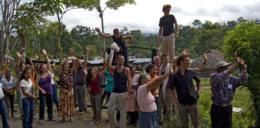What Holds a Community Together?

After a hundred years of failed community experiments since Monte Verità in Ascona, Italy (which also failed), one is justified in asking: What holds a community together, what stops it from failing and how is its power increased?
First of all it needs a strong idea, a concept, or a goal, which is more than a personal desire for contact and a feeling of home. Some examples would be building a peace garden, establishing a children’s republic, a school of transformation, an encompassing energy project, an art center, a media and communication center, etc. The more its concept corresponds to an objective necessity, the more it will be supported by the universe.
Secondly, it needs good methods to deal with human conflict. It needs a mental-spiritual concept, which remains effective even when human relationships threaten to break down.
Third, it needs a few responsible people, who have the strength to stand up for the community idea even when many things go wrong. It needs an unusually strong staying power.
Fourth, it does not need any top dogs or territorial thinking; instead, it needs cooperation among those who have taken on the main responsibility. A prerequisite for the creation of any community that has taken on a larger task is a permanent circle of responsible people, without secret competition for power and position.
Fifth, it needs a clear infrastructure. Every member should know their place and their task. Like every organ in the body, every person has a special function within the whole. Once a certain size has been reached, it is important to have a precise division of labor and a clear assignment of leadership functions.
Sixth, it needs a leadership structure that is free of domination, consisting of persons who are natural authorities, because they have the corresponding human and professional abilities and because they have the group’s trust. The character of these persons must be so mature that they do not misuse their position for self-interest and power. People with the old power structure are not suitable to function as leaders, even when they themselves immediately want to take on leadership roles. Future communities should neither have an authoritarian nor an anti-authoritarian basis.
Seventh, it needs the professionalism of their members. For the whole to develop, it needs a direction and a will that is not influenced by the momentary feelings and moods of the members. Freaks and hippies were often quite nice people, but they could not create functioning communities.
Eighth, in order for trust to grow, all important processes and decisions must be transparent. Especially in the areas of sex, love, authority and power, money and economy, it is necessary to create transparency using suitable methods (such as self-expression or Forum) and clear communication. Otherwise, the community will soon fall victim to hidden conflicts.
Ninth, it needs sexual vitality and liveliness. It will otherwise become rigid, ideological, or boring. In the past, communities either fell apart because of the Eros or else they suppressed it. Community and Eros were two opposing concepts. In reality, a free and honest Eros can only develop on a communitarian basis. For this to occur, the normal hindrances must be overcome in an appropriate way.
Tenth, it needs the re-commitment to the human basic values of neighborly love, hospitality, trust and mutual support. It needs the connection with the current issues of humanity and with the universal source of life. The more general human validity and meaning it has, the more power it will receive. The task then grows, the will strengthens and new possibilities become visible. Behind every project – be it a peace garden, an art or a technological center – there is a life concept, which becomes more encompassing the longer we work.
Eleventh, it needs authentic songs, feasts and rituals. For every community that develops and grows in a healthy way there comes a time when it celebrates its own feasts and finds its own rituals. This is when thankfulness and celebration naturally transform to a festive form of life. Suddenly the community finds songs of its own, its own icons, mantras and signs that focus its power and joy of life. At some point, every community of the future will begin each day with a kind of joint celebration.
This is an edited excerpt from the book: The Sacred Matrix by Dieter Duhm

